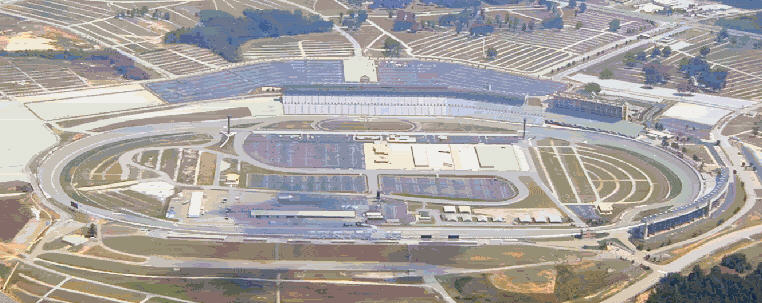Atlanta Motor Speedway, located in Hampton, Georgia, is a 1.540-mile quad-oval track owned by Speedway Motorsports, LLC. Since opening in 1960, it has hosted races from NASCAR and IndyCar. The speedway's capacity is 71,000. Besides the main track, it also features a 1/4-mile oval and a 2.5-mile roval road course. Brandon Hutchison is the track's general manager.
April 8, 1958: Plans to build announced
On April 8, 1958, the First Georgia Securities Corporation announced plans to build a racing facility.
1959: Initial Race Date Planned
In 1959, initial plans were made to host the first races at the facility.
1959: Dixie 500 Planned
In late 1959, the Dixie 500, originally planned as a 300-mile race, was set to debut.
June 1960: First Race Held After Construction Delays
Due to construction delays, the first race at Atlanta Motor Speedway finally occurred in June 1960. This was the Dixie 500, originally planned for 1959.
1960: Guardrail Installed
By late October 1960, a guardrail was installed in time for the Atlanta 500.
1960: First Races Held
In 1960, after delays, the first races were held at the facility.
January 1961: USAC Race Dates Confirmed and Later Cancelled
In January 1961, Atlanta Motor Speedway confirmed dates for a USAC-sanctioned race with Indianapolis-style cars, but the race was later cancelled due to safety concerns.
1962: Thundering Wheels Movie Production
In 1962, Atlanta Motor Speedway was used for the first time in movie production, specifically for the film "Thundering Wheels," featuring driver Jack Smith.
1963: Profit Announced
By mid-1963, the facility announced a profit of $179,046 for the year, displaying financial success.
1965: Dragstrip Plans Announced
In 1965, preliminary plans were announced to build a $500,000 dragstrip.
1967: Potential Sale Rumors
In 1967, rumors about the potential sale of AIR to prospective buyers were reported.
February 16, 1968: Weaver's Death
On February 16, 1968, Weaver died, leading to Jack Black replacing him as president of AIR.
December 1968: Merger with Michigan International Speedway
In December 1968, AIR merged with Michigan International Speedway, leading to plans for $1 million worth of renovations.
March 1969: Merger Approved
In March 1969, the merger was approved by the U.S. Securities and Exchange Commission (SEC).
1969: Company Fell Into Financial Trouble
By late 1969, American Raceways fell into financial trouble and merged with the STP Corporation.
1970: Plans to Sever Ties
In 1970, AIR directors initiated plans to sever ties from American Raceways due to financial troubles.
January 19, 1971: Filed Chapter 10 Bankruptcy
On January 19, 1971, Atlanta International Raceway officially filed for Chapter 10 bankruptcy.
1971: Atlanta 500 Attendance
In 1971, the Atlanta 500 drew a crowd of approximately 57,000, which, while less than expected, was viewed optimistically. Track ownership changes were also on the horizon.
1971: Chapter 10 Bankruptcy
In 1971, the track faced financial troubles and entered Chapter 10 bankruptcy.
1972: Storm Damages Atlanta Motor Speedway
During the 1972 Atlanta 500, a storm caused significant damage to Atlanta Motor Speedway, including concession stands and grandstands. Despite the destruction, the race still generated a profit.
April 1974: James Price Challenges Ownership Decision
In April 1974, James Price, a leading stockholder, challenged the decision to award ownership of Atlanta International Raceway to three individuals in the United States Court of Appeals for the Fifth Circuit.
January 1975: Court Denies Price's Bid
In January 1975, the court denied James Price's bid to challenge the ownership decision, effectively setting up control for the three individuals.
January 1976: Phase Two of Reorganization Begins
In January 1976, the second phase of Atlanta International Raceway's reorganization started, offering creditors options for their stock.
1978: Atlanta International Raceway Repaved
In 1978, Atlanta International Raceway underwent a repaving project that was completed by June.
1979: First Fatality at Atlanta International Raceway
During the 1979 Atlanta 500, the first fatality occurred at Atlanta International Raceway when Dennis Wade, a mechanic, was struck by a spinning racecar on pit road.
1980: Smokey and the Bandit II Filming
In 1980, Atlanta Motor Speedway was used for the filming of "Smokey and the Bandit II".
1982: Six Pack Filming
In 1982, the Daniel Petrie-directed film "Six Pack" used the Atlanta Motor Speedway for filming.
1983: Stroker Ace Filming
In 1983, Hal Needham directed "Stroker Ace", which was filmed at Atlanta Motor Speedway.
1984: Racer Death and New Wall Construction
In 1984, during the Atlanta Journal 500, a crash involving Terry Schoonover resulted in his death, leading to the announcement of new wall construction by general manager Mike Helton.
January 1986: $3 Million Renovations Announced
In January 1986, general manager Mike Helton announced $3 million in renovations at Atlanta International Raceway in preparation for the 1986 The Winston race.
1986: The Winston Hosted at Atlanta
In 1986, Atlanta Motor Speedway hosted a one-off iteration of The Winston (now known as the NASCAR All-Star Race).
September 1989: Roger Penske Offer to Purchase AIR Rejected
In September 1989, Roger Penske offered to purchase Atlanta International Raceway from DeWitt and Nix, but the offer was rejected on September 22.
February 22, 1990: Negotiations Begin for Sale of AIR to Bruton Smith
On February 22, 1990, local media reported that negotiations had begun between Nix and Bruton Smith, owner of Charlotte Motor Speedway, for the purchase of Atlanta International Raceway.
1990: Bruton Smith Purchase
In 1990, motorsports mogul Bruton Smith bought the facility, initiating expansion and renovation projects.
November 1991: Traffic Improvements and New Grandstand Completed
In November 1991, Atlanta Motor Speedway completed traffic flow improvements and the construction of a new 21,000-seat grandstand.
September 1992: Road Course Holds First Races
In September 1992, the new 2.5-mile road course at Atlanta Motor Speedway, known as the "roval", held its first races.
1992: Road Course Layout Added
In 1992, a 2.5 miles (4.0 km) road course layout was added, combining the main oval with an infield portion to create a "roval".
1993: Expansion Plans and Condominium Complex Announced
In 1993, Ed Clark announced a three-year plan to expand Atlanta Motor Speedway's capacity to 180,000, along with plans for a new condominium complex called Tara Place.
March 1994: Partial Opening of Tara Place
In March 1994, the $25 million Tara Place condominium complex at Atlanta Motor Speedway partially opened, despite slow initial sales.
1994: Clark Announces Further Renovations
In 1994, Clark announced further renovations to be completed by 2000, including adding 68,000 seats, expanding luxury boxes, and reconfiguring the track to a quad-oval.
1994: Tara Place Completion
In 1994, the nine-story condominium complex called Tara Place, featuring 46 units and a ballroom, was completed.
August 1995: New Grandstand Constructed
In August 1995, a new grandstand was constructed at Atlanta Motor Speedway, adding 21,000 permanent seats.
1997: Quarter-Mile Oval Added
As part of the 1997 reconfiguration, a 1⁄4 mile (0.40 km) oval was added on the track's frontstretch to accommodate legends car racing.
1997: Track Surface Width
From 1997, the racing surface width was at a recorded 55 feet with 24 degrees of banking in the turns.
1997: Indy Racing League Announces Race at Atlanta
In 1997, the Indy Racing League (IRL) announced plans to race a 500-kilometer race at Atlanta Motor Speedway starting in 1998.
1997: First Reconfiguration
In 1997, the track underwent its first major reconfiguration, changing the layout.
1997: Last Repave Until 2021
The last repave of the track was done until July 6, 2021.
2000: Renovations Scheduled to be Completed
The renovations announced in 1994, including the addition of 68,000 seats, expansion of luxury boxes, and the reconfiguration of the track, were scheduled to be completed by 2000.
July 2005: Tornado Hits Atlanta Motor Speedway
In July 2005, an F2 tornado caused by the remnants of Hurricane Cindy struck Atlanta Motor Speedway, resulting in approximately $40 million in damages.
2010: Peak Capacity
According to a 2010 report by the Atlanta Magazine, the facility held a maximum of 124,000.
2015: Reported Capacity
As of 2015, the track had a reported capacity of 71,000.
2015: Seating Capacity Decreases
By 2015, Atlanta Motor Speedway's seating capacity decreased to 71,000, according to NBC Sports.
2017: Used as Evacuee Center for Hurricane Irma
In 2017, Atlanta Motor Speedway was used as an evacuee center during Hurricane Irma.
2017: Logan Lucky Filming
In 2017, the movie "Logan Lucky" used the Atlanta Motor Speedway as a stand-in for Charlotte Motor Speedway.
2018: Used as Evacuee Center for Hurricanes Florence and Michael
In 2018, Atlanta Motor Speedway was used as an evacuee center during Hurricane Florence and Hurricane Michael.
2018: Seating Removed for Hospitality Area; New General Manager
In early 2018, Atlanta Motor Speedway removed an unspecified number of seats to construct a hospitality area. Later that year, Ed Clark stepped down as general manager and Brandon Hutchison took over.
December 2019: Clark Announces Retirement
In December 2019, Clark announced his retirement from his position as president of Atlanta Motor Speedway, effective in March 2020.
2019: Used as Evacuee Center for Hurricane Dorian
In 2019, Atlanta Motor Speedway was used as an evacuee center during Hurricane Dorian.
2019: Clark Announces Proposal for Entertainment Complex
In late 2019, Clark announced a proposal to build a $1 billion entertainment complex contingent on the legalization of gambling in Georgia.
January 2020: Hearing Scheduled for Gambling Proposal
In January 2020, a hearing was scheduled in the Georgia House of Representatives regarding the proposal to legalize gambling and build an entertainment complex near Atlanta Motor Speedway.
March 2020: Clark's Retirement Takes Effect
In March 2020, Clark's retirement from his position as president of Atlanta Motor Speedway took effect, giving complete control to Brandon Hutchison.
2020: The Winston Moved From Charlotte
In 2020, The Winston was moved from Charlotte Motor Speedway, its permanent home since 1986.
March 2021: Revived Support for Gambling Proposal
In March 2021, the gambling proposal saw revived support as Georgia showed increased interest in online sports betting, with Clark campaigning for legalization.
July 6, 2021: Repave and Reconfiguration Announced
On July 6, 2021, a repave and reconfiguration of Atlanta Motor Speedway was officially announced, including increased banking in the turns.
2021: Capacity Statistics Refusal
As late as 2021, the track's parent company, SMI, refused to release capacity statistics.
2021: Second Reconfiguration
In 2021, a second major reconfiguration occurred, altering the style of racing to resemble superspeedway pack racing.
2021: Atlanta Marathon Moved to Speedway and Perimeter Roads
In 2021, the Atlanta Marathon was moved to Atlanta Motor Speedway and its perimeter roads due to COVID-19 restrictions.
2021: Track Surface
Until 2021, the racing surface was at a recorded 55 feet with 24 degrees of banking in the turns.
2022: Stagnation of Gambling Proposal Support
By 2022, although Hutchison and Clark were still campaigning for gambling legalization and the entertainment complex, support for the proposal had essentially stagnated.
2022: Used as Evacuee Center for Hurricane Ian
In 2022, Atlanta Motor Speedway was used as an evacuee center during Hurricane Ian.
2023: Used as Evacuee Center for Hurricane Idalia
In 2023, Atlanta Motor Speedway was used as an evacuee center during Hurricane Idalia.
February 2025: Fastest Lap Records
As of February 2025, the fastest official race lap records at the Atlanta Motor Speedway were compiled.
Mentioned in this timeline

Jack Black born Thomas Jacob Black is a celebrated American...
The National Broadcasting Company NBC is a major American commercial...

A tornado is a rotating column of air connecting the...

A car also known as an automobile is a wheeled...

Hurricane Michael was an exceptionally powerful and destructive tropical cyclone...
Michigan is a peninsular state in the Great Lakes region...
Trending

1 month ago DeAndre Hopkins chases history as Lamar Jackson seeks a bigger target role.

7 months ago Aaron Rodgers' Marriage Sparks Family Drama; Quarterback Finds Solace with Steelers

Anne Frank was a German-Jewish girl who gained posthumous fame for her diary which documented her family's life in hiding...
5 months ago Matt Chapman to IL with hand inflammation; Giants recall Landen Roupp.

9 months ago Bobby Portis returns, inspires Bucks' win; Kevin Porter Jr. Mentioned.

9 months ago Bobby Portis: From Turmoil to Triumph, Focused on Bucks Playoff Series
Popular

Stranger Things created by the Duffer Brothers is a popular...

XXXTentacion born Jahseh Dwayne Ricardo Onfroy was a controversial yet...

Kelsey Grammer is an accomplished American actor producer and singer...

Candace Owens is an American conservative political commentator and author...

Bernie Sanders is a prominent American politician currently serving as...

Melania Trump a Slovenian-American former model has served as First...
